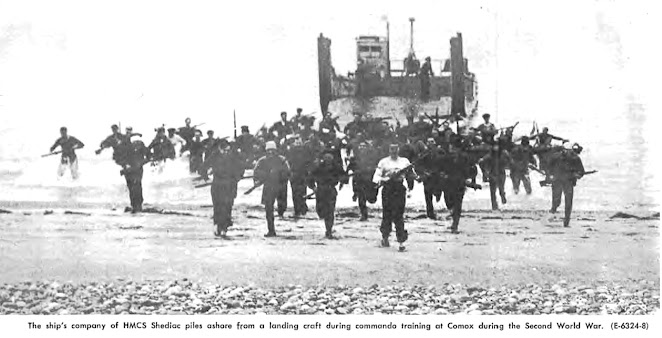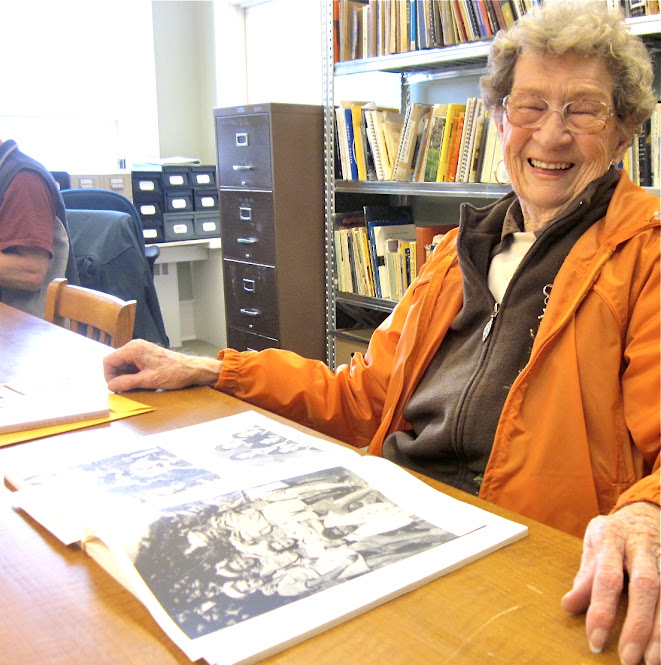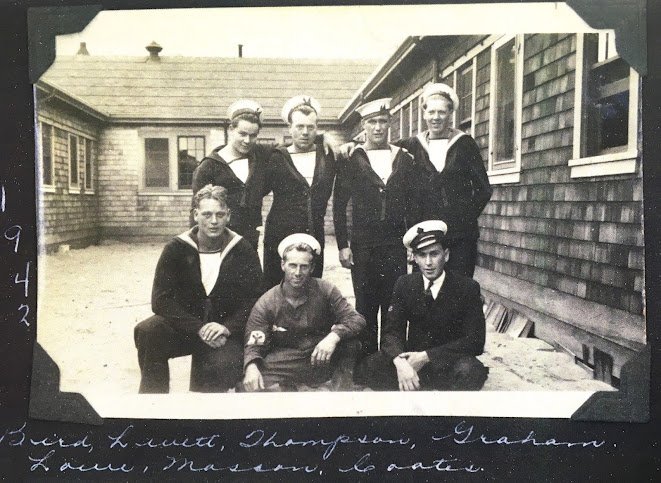Scores of Canadians in Combined Ops Stationed on The Spit
Rare Combined Operations School (C.O.S.) 1943 - 1946
"Commando training at Comox during the Second World War"
Photo Credit - The Crow's Nest, March 1958 edition
Earlier Gov. oyster beds were likely to the right of the buildings, centre
Photo Credit - The Crow's Nest, March 1958 edition
The tide may be out in this later photo of HMCS Quadra on The Spit
The presence of the Navy is still felt on The Spit at time of writing this, and the overall appearance of the current base, HMCS Quadra, has not completely erased the look of the site since World War II.
Great changes are nonetheless evident and we must go back to books by local historians and memoirs by WWII sailors (penned on paper and online, etc.) in order to understand more about what the Canadian Navy base was like during World War II.
I think that the Canadians in Combined Operations who volunteered for/were assigned service at HMCS Givenchy III from January 1944 - late summer 1945 had a positive view of what the base was like. Most had life pretty good there.
I think that the Canadians in Combined Operations who volunteered for/were assigned service at HMCS Givenchy III from January 1944 - late summer 1945 had a positive view of what the base was like. Most had life pretty good there.
In my father's first remembrances of the base (in his hand-written memoirs), he writes:
Then I went to Givenchy III. known as Cowards Cove, at Comox on Vancouver Island. It was absolute heaven there. Just normal routine; I trained a few zombies on cutters, and played ball five or six times a week under a good coach (G. Hobson, later a mayor of Courtenay)... I also looked after Captain Windyer's (sic) sailboat and prepared it when he wished to go for a sail...
(On one occasion my father had to take out an LCM to rescue the Captain. An LCM is featured in the top photo. During WWII most of Canada's landing craft were stationed on Vancouver Island).
In the December 23, 1943 issue of the Comox District Free Press (found on microfilm at the Courtenay Library) one can read an article related to "an informal talk on convoy work" delivered by "Commander G. S. Windeyer" to members of the Elks' Club (Comox or Courtenay). It appears in its entirety below:
The next paragraph says:
"It has expanded from only seven corvettes to more than thirty at the present time, the speaker said, adding his personal opinion that if it had not been for this force the Allies would have lost the war.
The article continues:
The next paragraph says:
One of their most exciting jobs had been to dash out and bring in the Battle Cruiser "Repulse" during the Bismarck show in the North Atlantic. The big battleship had only a pint of oil left. The corvette gave her (i.e. Repulse) some and later brought up a tanker to refuel her before she again took up the chase of the ill-fated battleship.
The article continues:
In Windeyer's concluding statements he mentions the Combined Operations School and the background of some of the Canadian sailors who served there:
In conclusion he declared that his duties in connection with the Combined Operations School had been made ever so much more pleasant by the splendid manner in which the people of Courtenay and Comox had put themselves out to make the officers and men happy and comfortable.
The article continues:
Please note - some of the members of RCNVR on the Navy base prior to this article being written may have also trained for and participated in the Dieppe Raid (August 19, 1942) prior to the subsequent invasion of North Africa less than 3 months later (beginning November 8, 1942). Many of the members of RCNVR and Combined Ops who arrived at HMCS Givenchy III beginning in Jan. 1944 (just a few weeks after the article's publication) had trained for the Dieppe Raid in Scotland and S. England a few months prior to the raid. Any omission by Comm. Windeyer may be related to lack of detail in the navy records of the time. The word 'sparse' could be used to describe some files.
The article concludes (please excuse my penmanship):
One of the sailors who had been at the Navy base prior to Windeyer's arrival (e.g., in 1941 or 1942 and had gone on to serve overseas (e.g., in Sicily, July 1943) before returning to the Navy base on Canada's West Coast in Jan. 1944 was AB Chuck Levett. I met his wife Dorothy in 2012 and 2015 while in Comox/Courtenay region. She had a particular photo of Chuck that I was familiar with, having found it myself only a few days earlier in a rare book by Canadians in Combined Operations that had been purchased by my father in the mid-1990s (I got more familiar with the book and photo while travelling by train from Toronto to Vancouver in 2012):
Dorothy Levett possessed a copy of a photo from the book I showed her.
Summer 2012, Courtenay Museum. (Photo from the book appears below)
Chuck Levett - left, first row standing. To Chuck's left is W. (Bill) Grycan
Bill appears in photos of Navy No. 1 baseball team, 1944 - 45, Comox
Enlarged photo of Chuck and Bill, as found in Combined Operations
by Londoner Clayton Marks. Page 89
Chuck Levett was given the above certificate after crossing the Equator
for the first time, on his way to Operation Husky, the invasion of Sicily
in 1943. He was a member of the 55th Canadian Flotilla of ALCs
Photo credit - Dorothy Levett, 2012
Chuck passed away at a relatively young age and Dorothy passed away in 2020 approx. I have been in contact with their son Rob Levett of Campbell River, Vancouver Island and he has generously provided bme with the use of several of his parents' photographs, most dealing with Chuck's time at the navy base on The Spit:
Chuck "Comox" Levett (RCNVR, Combined Ops) trains US troops to get in
synch with the oars on a navy cutter. August 1944, The Spit, Comox BC
Photo - Used w permission of Rob Levett, son of Chuck and Dorothy
A couple of other photos provided to me by Rob Levett can be found at a post entitled Editor's Research: Canadians in Combined Ops Return Home, Part 10.
More photos from the Navy base on The Spit - along with significant details of its history leading up to and including World War II - and the relatively brief time my father and mates were there from Jan. 1944 - summer 1945 - can be found online at For Posterity's Sake, a Royal Canadian Navy Historical Project in a piece attributed to in The Crowsnest Magazine, March 1958 edition. Though the photos - courtesy of sailor Jim Silvester - are small and in low resolution (making in hard to zoom in to see details), they provide a good sense of the size and condition of the navy base in the early 1940s.
The lengthy article begins as follows:
A tender to Naden at Esquimalt, the new establishment had as its first commanding officer Lt.-Cdr. Leslie Harrison, RCN.
(The editor of this blog is hoping Lt.-Cdr. Harrison is a distant relative and has left him the keys to The Spit in his will).
One can read about improvements to the property, e.g., re a new jetty, and "a $3,000 plank road to the butts, required because of the shifting sands... completed by mid-March 1941." By November, 1941 there were "some 400 ratings stationed at Comox... sick bay facilities were practically non-existent" but a "tiny eight-bed hospital" was built shortly thereafter.
One can read about how the original role for the base (i.e., "to take trained men from Naden (in Esquimalt, BC) for gunnery and seamanship courses while they awaited their drafts to sea") grew more demanding "as the war progressed" and by December, 1942 its responsibilities began to focus on Combined Operations.
In the Crowsnest Magazine article we learn the following:
Sandy and Tunnicliffe (back), Tom and Silvester (front) at HMCS
Naden III. From the collection of Jim Silvester
In some of the final paragraphs presented in the article we read of the time on The Spit that includes the members of RCNVR and Combined Operations that include my father and numerous mates who returned to Canada in December 1943 (post their involvement - for many young recruits - in Dieppe, North Africa, Sicily and Italy) and soon thereafter were posted to HMCS Givenchy III. We read:
As the assault craft began to concentrate -in Comox Harbour the rather primitive facilities of the camp at Courtenay were soon overtaxed. That summer "combined ops" moved to what was now a very well established naval base, Naden (III), on Goose Spit. In fact on the spit, "combined ops" became the primary activity, and the base was commissioned HMCS Givenchy (III) on October 1, 1943.
Some of the Comox (Naden III) Kids. (New 'drill shed'
in background?) From the collection of Jim Silvester
Sailors (names included) on The Spit, 1942. Older buildings?
Photo - From collection of Chuck Levett (back row, 2nd left)
Typical of the training carried out at Comox was that of September 1944, when the Midland Regiment received training in Givenchy (III). These are excerpts from the Report of Proceedings: Three assault craft exercised "C" Company in boat drill; six craft exercised Support and Headquarters Companies as well as "A" Company in boat drill and landing net procedure; three craft drilled "D" Company in landings on Goose Spit; four companies in nine craft practised landings on Sandy Isle; five cutters were employed teaching soldiers boat pulling.
I acted as Coxswain on large navy cutters as soldiers worked the oars. The cutters were 27 feet long and wide enough (except at the bows) to seat four men, two men to an oar. This was fun, getting the proper stroke amongst 18 green oarsmen. If the rhythm was wrong and an oar caught a crab (got stuck in the water), the effect was that nearly every thwart was cleared of oarsmen and bedlam prevailed. “Stroke! Stroke! Stroke!” I hollered, bursting from laughter. The oars are about 12 feet long and are they ever heavy. To give the soldiers a well-earned rest I would give the order “Rest oars.” Then the oars would be pulled in, rested on each side of the cutter, and the soldiers could rest their weary arms on the looms for awhile.
“I enjoyed giving the order to toss oars” at The Spit, Comox BC
Photo credit - Sailor Remember by W. H. Pugsley
"Dad, Well Done", navy memoirs by Doug Harrison, Page 127
Please click here to visit For Posterity's Sake to view all photos by Jim Silvester and read the full article as presented in the March 1958 issue of The Crowsnest Magazine.
Please link to more information concerning the navy base on The Spit at Comox during World War II @ The Comox District Free Press (1).
Unattributed Photos GH
Please click here to visit For Posterity's Sake to view all photos by Jim Silvester and read the full article as presented in the March 1958 issue of The Crowsnest Magazine.
Please link to more information concerning the navy base on The Spit at Comox during World War II @ The Comox District Free Press (1).
Unattributed Photos GH






















No comments:
Post a Comment